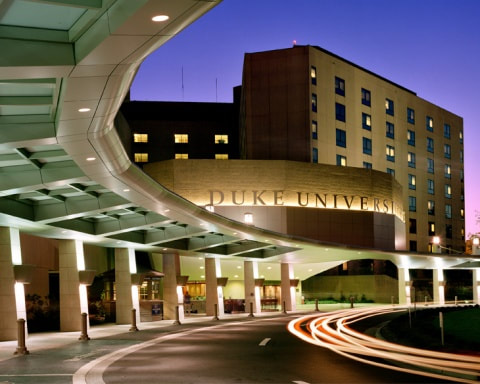|
The time had finally come to start my final immersion at Duke University Hospital in Durham, NC. I was excited, but mostly nervous about what I would experience. This immersion would be like no other because we were facing the early stages of the COVID-19 pandemic. PPE was running low at most hospitals, screening was not being done enough around the country, and more people were becoming hospitalized due to COVID-19. I was worried for my own health, but I knew Duke had taken great measures and precautions for the safety of not only the patients, but healthcare workers as well.
On my first day arriving at Duke, I immediately saw signs for wearing masks on campus everywhere. At Duke everyone on campus even outside of the hospital were required to wear masks at all times. As soon as I entered the hospital my temperature was taken, I was asked questions regarding my symptoms, and was given a new sticker each day to wear to show that I was healthy. My first month of rotations was in cardiology. One concern in cardiology, was the resemblance of certain classic symptoms such as shortness of breath and cough for heart failure being similar to COVID-19. Fortunately, all patients were screened rapidly for COVID-19 when admitted, so the chances of these symptoms being COVID-19 were relatively low. Since I was doing my clinical direct patient care immersion, typically this would require rounding in patients’ rooms with the team to decide on diagnosis and treatment. However, with COVID-19 pharmacy students were not allowed to enter patient rooms, but we were able to still round with the team going door to door to make recommendations. I remember seeing some interesting patient cases such as a patient who was diagnosed with Takotsubo cardiomyopathy, otherwise known as broken-heart syndrome. This patient was a previously healthy female and had a normal ejection fraction until her husband unexpectedly passed away. Her ejection fraction in the hospital was around 20% and was immediately classified as a heart failure patient due to this syndrome. During my second month at Duke I rounded in the pediatric floor. I loved working with and seeing all the children. It was devastating to see children in the hospital, however their resiliency and braveness at such a young age inspired me. All of the children I met from afar had such a positive attitude no matter what their diagnosis or illness was, which was truly astonishing to me. Some unfortunate few cases we saw at the hospital, which was new to all of the medical providers was MIS-C in regards to COVID-19. MIS-C otherwise known as multisystem inflammatory syndrome in children is a rare complication that can occur in this case due to an exposure to COVID-19 and can cause different parts of the body to shut down if not treated properly. I was able to present this new syndrome to the pharmacists along with treatment options. Although my last immersion was not exactly how I expected it to be, I am prouder than ever to be a part of a healthcare team in a time like this when healthcare workers are vital in defeating this pandemic. My appreciation for all medical providers and frontline workers definitely heightened as they dealt with the most difficult challenges this pandemic offered. I hope to one day become a strong and resilient healthcare provider as they are. Written by: Sarah Mouna REFERENCE: https://www.dukehealth.org/hospitals/duke-university-hospital
0 Comments
Leave a Reply. |
�
Categories
All
Archives
October 2022
|


